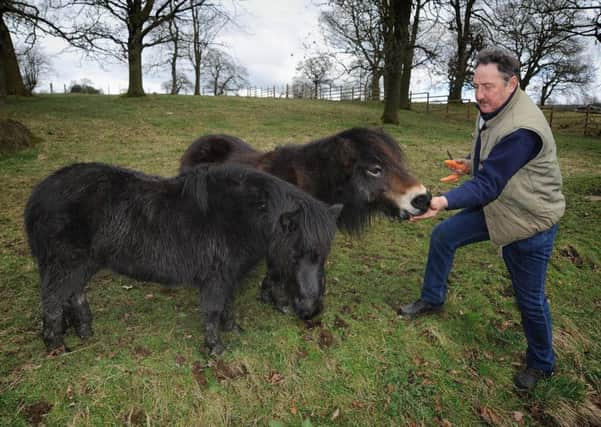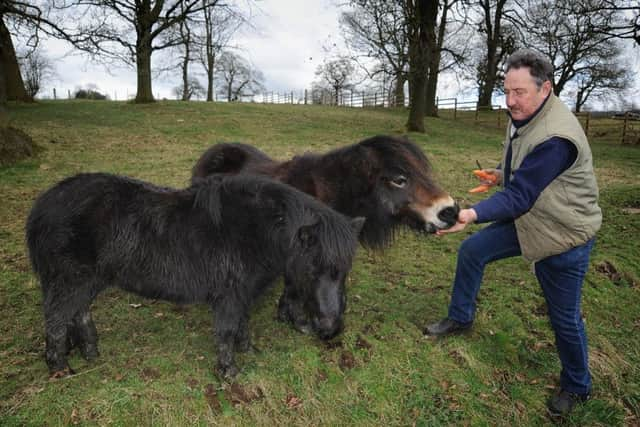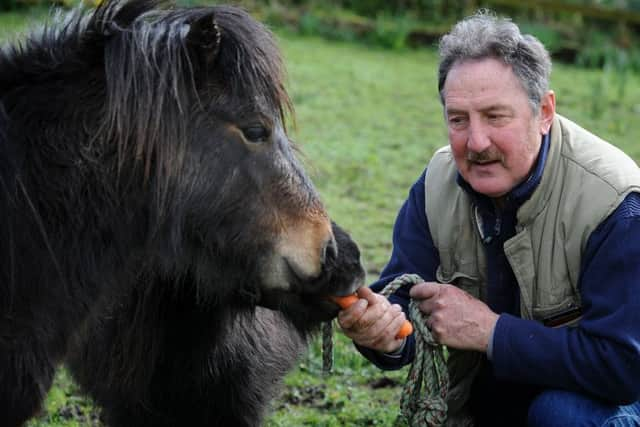Harry's mission to protect Shetlands


Burnley’s horse-whisperer has spent the last six years building a Shetland sanctuary on Smithson Farm, Wood End, Reedley Hallows.
His wife, Carole, runs a caravan park, tea room and the Woodend Mining Museum, based on the coal pits which once stretched beneath their land.
Advertisement
Hide AdAdvertisement
Hide AdUpon retiring 13 years ago, the couple bought two acres of derelict land with the aim of setting up a livery stable for larger breeds, instead deciding to rehome Shetlands.


“Growing up, my dad had a farm,” he said. “I spent my youth driving coaches all over Europe but I always wanted to get back to having land. It’s in your blood.”
“When we came to the area, the land was derelict – it hadn’t been touched in 15 years. We’ve done everything [to renovate it] ourselves.”
Today, the farm is a patchwork of green, home to parrots, dogs, chickens and 10 Shetlands: seven rescues; three offspring. It’s hard to imagine the rocky cuttings which once snaked beneath.
Advertisement
Hide AdAdvertisement
Hide AdHarry’s first horse, Robbie, was adopted from a riding school that crumbled due to a lack of funding. The 11-year-old is a Miniature – tiny even by Shetlands’ standards – and not much taller than a Labrador. Standing at only 80cm, his son, Callum, is already taller at three years-old.


After Robbie, Harry visited an auction to purchase a second – but ended up taking home two. Struck as he was by their desperate circumstances, he returned a week later to save two more.
“There’s a problem in the horse industry of over-breeding,” he said. “People buy horses and don’t realise it’s a seven-days-a-week job. And if they’re not sold at auction, they go to slaughter.”
“Girls want a pony and traders bring them straight in from the Shetland Islands. People buy them to sell - they’re just a commodity to some people.”
It’s an issue stretching across the UK.


Advertisement
Hide AdAdvertisement
Hide AdAs World Horse Welfare Deputy Chief Executive, Tony Tyler, said: “There are at least 3,500 horses at risk and thousands more horses than there are good homes, and one of the biggest contributing factors to this problem is over-breeding. The sheer numbers of horses available or looking for homes means the market is absolutely flooded with low value animals, putting them at severe risk of welfare problems.”
Harry had never bred horses before Robbie’s son, Archie, came along four years ago, then Callum the year after.
“I love them – they keep the grass down,” he joked.
And he’s not the only one.


One woman regularly visits with her young, struggling son – “they’re therapeutic for people” – and passers-by often stop to throw them apples. In fact, members of the public are welcome to arrange a visit.
While they may be small – and pampered by their neighbours – they’re undoubtedly tough.
Advertisement
Hide AdAdvertisement
Hide Ad“They’re very hardy and strong. They like to stay outside, even in bad weather,” Harry added. “They’re not bothered by snow – they’re well insulated.”
In fact, Shetlands were the preferred breed for use underground as pit ponies, owing to their size, strength and durability. Inhabiting the Shetland Isles for more than 2000 years, the breed has evolved to survive the harsh fickleness of the environment, including the sparsity of grassland, unlike their larger counterparts. Thousands were thus exported to carry loads of coal in the mines.
“They were still being used in the 1950s,” Harry added. “The last horse to be used by the National Coal Board was in 1994 and privately in 1999. They were bred to be small enough to fit in the 40inch shafts.”
According to Graham Topping, a former mine manager and a member of the Northern Mines Research Society (NMRS), pit ponies were use at Bank Hall Colliery and the Cliviger Railway Pit. In the Burnley Coalfield, the seams were as low as 18-inches and there were few places where the roof was high enough for ponies of any size.
Advertisement
Hide AdAdvertisement
Hide AdBut, Graham added, the horse was part of the family and well-looked after. Burnley and Cliviger had better conditions than elsewhere: in Bank Hall, they were brought to the surface from end of work on Saturday until Monday morning; at Railway Pit, Cliviger, they pulled trains of coal tubs up the inclined shaft, coming out into the light at the top end.
Ponies, he said, were bred for work and if none work was found, they might be destroyed.
But the work of course was steeped in danger: men and horses alike were killed by cave-ins and explosions.
“Some never saw daylight,” Harry said, “and when the pit was wet, they’d often catch rheumatism.”
Advertisement
Hide AdAdvertisement
Hide AdToday, the context may be different but for Harry, Shetlands continue to exist in a world of commodification. But at Smithson Farm, the assertiveness and individuality of each member of this little, equine family blaze through.
“They can be a bit feisty but they’re all different, like children: Robbie’s really quiet; Dougal is a bit stand-offish, a lady’s pony; Mari is placid like her dad; Rona is a good mother, loving and friendly; while Ellie is very shy and prefers girls.”
No doubt, you only need to spend a few minutes with these little beauties to see they’ve been sold significantly short by the equine industry.
For more information or to arrange a visit of the mines or ponies, please call 07809 274910 or 01282 420701.